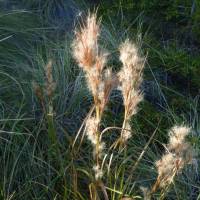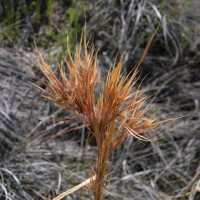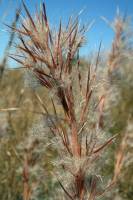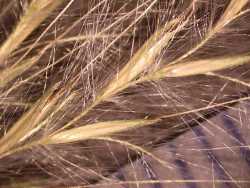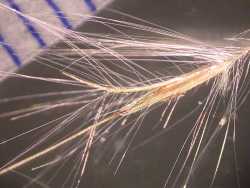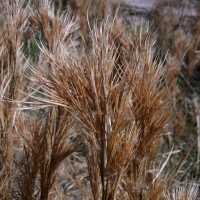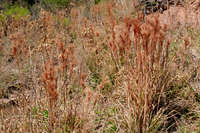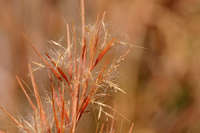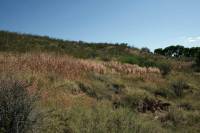Plants cespitose, upper portion dense, oblong to oblanceolate or obpyramidal. Culms 20-250 cm; internodes green, sometimes glaucous; branches mostly erect, straight. Sheaths usually scabrous, sometimes smooth; ligules 0.6-2.2 mm, sometimes ciliate, cilia to 0.9 mm; blades 13-109 cm long, 2.9-9.5 mm wide, glabrous or sparsely to densely pubescent, hairs usually spreading, rarely appressed. Inflorescence units 10-600 per culm; subtending sheaths (2.0)2.9-4.4(6.5) cm long, (1.5)2.3-3.4(4.4) mm wide; peduncles (1)6-14(60) mm, with 2(4) rames; rames (1)1.7-2.5(3.5) cm, exserted or not at maturity, pubescence sparse basally and increasing in density distally within each internode. Sessile spikelets 3-5 mm; callus hairs 1-2.5 mm; keels of lower glumes sometimes scabrous below midlength, usually scabrous distally; awns 6-19 mm; anthers 1(3), 0.5-1.5 mm, yellow, red, or purple. Pedicellate spikelets vestigial or absent, sterile. 2n = 20.
Andropogon glomeratus hybridizes with both A. longiberbis and A. virginicus. Some of its varieties are morphologically similar to the latter species.
Common Name: bushy bluestem
Duration: Perennial
Nativity: Native
Lifeform: Graminoid
General: Native perennial bunchgrass 0.5-1.5 meters tall with long leaves and large, thick, red-brown, broom-like inflorescences
Vegetative: Cespitose, stems 20-250 cm long, erect, mostly with many branches above; ligules 1-2 mm long, sometimes with cilia < 1 mm long; leaves with usually open sheathes, blades mostly flat, 13-109 cm long, 3-9 mm wide.
Inflorescence: Numerous inflorescence units per stem, with subtending sheaths 3-4 cm long, 2-3 mm wide; peduncles with 2 rames, peduncles 11-35 mm long; rames 1.5-2.5 cm long with little pubescence along base and increasing pubescence distally; spikelets sessile, 3-5 mm long; glumes generally 2, lower glumes keeled, glabrous; lemmas with awns 1-2 cm long; pedicellate spikelets rudimentary or absent.
Ecology: Found in marsh borders, in moist pine forests and along streams and low-lying roadsides at 1200-4000 ft. Flowers July-October.
Distribution: Found in New Mexico, Arizona, Utah, Nevada, California, Texas, Oklahoma, and most states in the East.
Notes: Can live in hot environments as long as it has sufficient moisture. Hybridizes with A. longiberbis and A. virginicus.
Ethnobotany: Roots have been used medicinally for backaches and hives. Presently used as an ornamental grass because of its rust-colored showy plumes.
Etymology: Andropogon comes from the Greek andros, meaning man, and from pogon, meaning beard; in reference to the spikelets' hairs, resembling a man's beard; glomeratus means clustered.
Synonyms: None
Editor: Lkearsley2012
Lvs usually 3.5 dm or more; stem-sheaths usually scabrous; infl compact, obconic or corymbiform, densely glomerately branched, the internodes greatly shortened; uppermost nodes mostly villous; fertile spikelets avg 4.2 mm; sterile spikelet commonly present; wet soil; W.I. and C. Amer., n. to Calif., Ark., Ky., Va., and along the coastal plain to Mass. (A. glomeratus)
Gleason, Henry A. & Cronquist, Arthur J. 1991. Manual of vascular plants of northeastern United States and adjacent Canada. lxxv + 910 pp.
©The New York Botanical Garden. All rights reserved. Used by permission.



